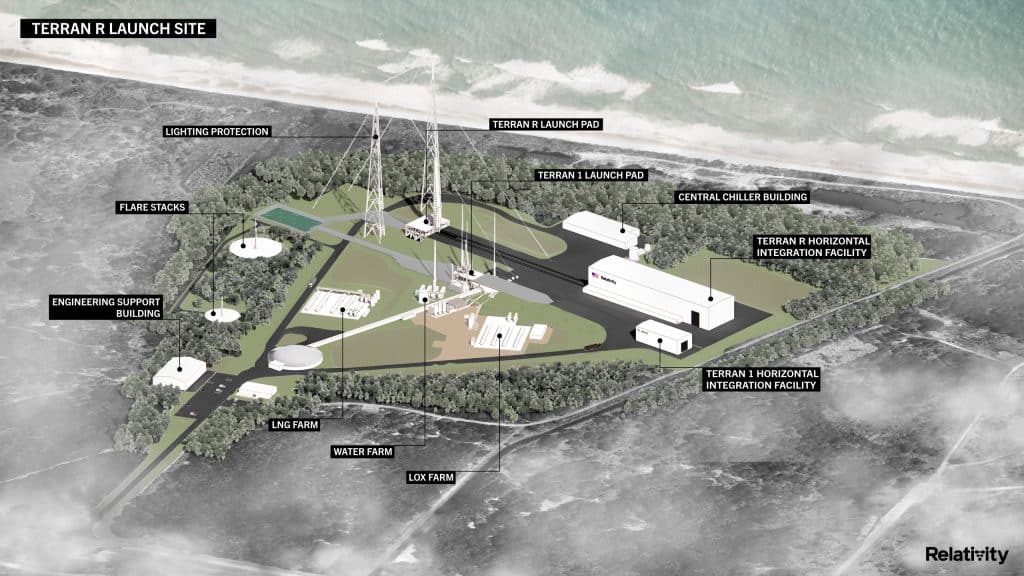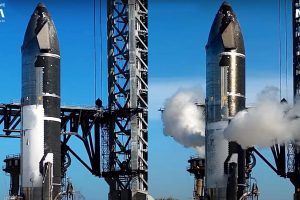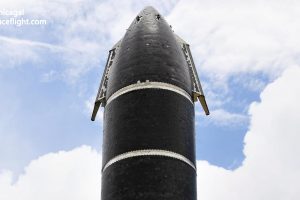- 🚀 Relativity Space has made significant changes to Space Launch Complex 16 at Cape Canaveral Space Force Station to prepare for the launch of its Terran R rocket.
- 🏗️ The previous infrastructure built for the Terran 1 rocket has been largely demolished to make way for the larger Terran R facilities.
- 🏭 Relativity Space plans to construct a new horizontal integration facility capable of accommodating multiple Terran R rockets before launch.
- ⛽ The location of the fuel farm appears to have been modified compared to earlier renderings, but the overall layout remains roughly the same.
- ⏰ Relativity Space aims to launch the Terran R sometime in 2026, after completing tests at NASA’s Stennis Space Center.
- 💨 The company has been conducting wind tunnel tests on a Terran R model to validate its design and guidance through the atmosphere.
- 🔍 The article invites readers to share their thoughts on Relativity Space’s progress and the competitiveness of the rapidly growing market for new launchers.
Relativity Space, the pioneering aerospace company known for its innovative 3D-printed rockets, is leaving no stone unturned in its preparations for the highly anticipated launch of the Terran R rocket. The company has made significant strides at Space Launch Complex 16 (SLC-16) at Cape Canaveral Space Force Station, where the Terran R will take flight on its maiden voyage.
Demolishing the Past, Paving the Way for the Future
In a bold move, Relativity Space has demolished much of the existing infrastructure that was previously constructed for the smaller Terran 1 rocket. This decision underscores the company’s commitment to creating a launch complex tailored specifically for the larger and more powerful Terran R.
The Terran 1 rocket, while a remarkable achievement in its own right, was merely a stepping stone towards Relativity Space’s grander ambitions. With the successful test flight in March 2023, which validated the 3D-printed rocket’s ability to withstand maximum aerodynamic pressure, the company gained the confidence to forge ahead with the Terran R program.

A Cutting-Edge Launch Complex for a Revolutionary Rocket
One of the most significant additions to SLC-16 will be a new horizontal integration facility designed to accommodate multiple Terran R rockets simultaneously. This state-of-the-art facility will streamline the pre-launch preparations, allowing for efficient and parallel operations.
While the current Terran 1 launch pad will remain intact, Relativity Space will construct a brand-new launch pad from the ground up, specifically engineered to handle the immense forces exerted by the 13 Aeon R engines that will power the Terran R during liftoff.
Optimizing the Layout for Operational Efficiency
Although the overall layout of SLC-16 remains largely consistent with earlier renderings, Relativity Space has made adjustments to the location of the fuel farm. This strategic decision reflects the company’s commitment to optimizing operational efficiency and ensuring seamless integration with the new facilities.
Rigorous Testing for Uncompromising Performance
Relativity Space is leaving no stone unturned in their quest for perfection. They have been conducting extensive wind tunnel tests on a Terran R model, meticulously validating the rocket’s design and guidance capabilities as it navigates through the Earth’s atmosphere. These tests are crucial in ensuring that the Terran R performs flawlessly during its inaugural launch, scheduled for 2026.
Moreover, the company’s state-of-the-art test stand at NASA’s Stennis Space Center is nearing completion, enabling Relativity Space to conduct comprehensive tests on the powerful Aeon R engines at an accelerated pace. This cutting-edge facility will play a pivotal role in ensuring the engines meet the stringent performance requirements for the Terran R.
A Rapidly Growing Market for Private Space Exploration
As Relativity Space forges ahead with its ambitious plans, the private space exploration sector is witnessing unprecedented growth and competition. With numerous companies vying to establish themselves as leaders in this rapidly evolving industry, Relativity Space’s innovative approach and unwavering commitment to pushing the boundaries of rocket engineering position them as a formidable contender.
The article invites readers to share their thoughts on Relativity Space’s progress and the competitiveness of this burgeoning market. Are you excited about the prospect of witnessing the Terran R’s maiden voyage? Do you believe Relativity Space’s pioneering approach will give them a competitive edge in the private space exploration arena?
Join the conversation and share your insights, as we collectively witness the unfolding of a new era in space exploration, driven by the audacious vision and groundbreaking innovations of companies like Relativity Space.





